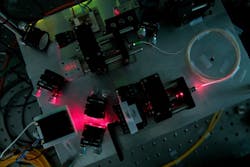Fiber-optic quantum-key distribution technique perfectly times photons’ arrival
Taking advantage of existing underground fiber networks to transmit entangled photons is essential for deploying practical quantum-key distribution (QKD) systems, which will create encryption keys for secure communication that is resistant to all computational hacks. Researchers at the National University of Singapore (NUS) and Singtel (both in Singapore) have now demonstrated a technique that will help pairs of entangled photons smoothly navigate these networks. The QKD trials carried out by the NUS-Singtel team use pairs of photons that are connected via entanglement. Most QKD schemes require that the sender and receiver of a secret message exchange photons directly or trust the source of their keys. With this alternative approach, it is possible to check the security of a key provided by a third-party supplier.
Typically in QKD, each photon of the pair encounters a different obstacle course of spliced fiber segments and junction boxes. On their paths, the photons also suffer dispersion, which affects the operators’ ability to track the photons. The new trick keeps the entangled photons in sync as they travel different paths through the network. This is important because they are identified by the gap between their arrival times at the detector. The technique works by designing the photon source to create photon pairs with wavelengths that are on either side of the zero-dispersion wavelength of the optical fiber. Normally, in optical fibers, “bluer” photons arrive faster than “redder” photons, spreading out the photons’ arrival times. Working around the zero-dispersion point makes it possible to match the speeds through the photons’ time-energy entanglement. Thus, the timing is preserved.
In showing it can work, the team boosts expectations for QKD over commercial fiber. The entangled photons could find other applications, too. For example, the photons in each pair are created within femtoseconds of each other; their coordinated arrival times could synchronize clocks for time-critical operations such as financial trading. Reference: J. A. Grieve et al., Appl. Phys. Lett., 114, 131106 (2019); https://doi.org/10.1063/1.5088830.
About the Author
John Wallace
Senior Technical Editor (1998-2022)
John Wallace was with Laser Focus World for nearly 25 years, retiring in late June 2022. He obtained a bachelor's degree in mechanical engineering and physics at Rutgers University and a master's in optical engineering at the University of Rochester. Before becoming an editor, John worked as an engineer at RCA, Exxon, Eastman Kodak, and GCA Corporation.

